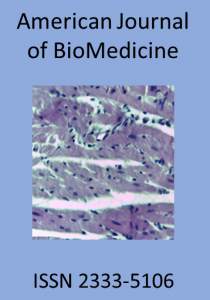Research Article
American Journal of BioMedicine
Volume 12, Issue 1, 2024, Pages 21-32 ![]() 10.18081/2333-5106/2024.12/21
10.18081/2333-5106/2024.12/21
Yung-Cho Hsu1 ![]() , Shu-Chang Hsiao
, Shu-Chang Hsiao ![]() ,Hong Wen Huang
,Hong Wen Huang![]() , Ping Yang Ho, Ching-Yi Lin, Ta-Chun Chuang
, Ping Yang Ho, Ching-Yi Lin, Ta-Chun Chuang ![]() *
*![]()
Received 24 August 2023; revised 30 October 2023; accepted 14 December 2023; published 31 March 2024
Abstract
Imipramine is an antidepressant drug (ADs) that shows therapeutic efficacy in a maximum of 60–80% of patients who have experienced a major depressive episode (unipolar or bipolar). The purpose of the study was to investigate the pharmacokinetics of a multi-oral dose of Imipramine 25 mg tablet in a Taiwan healthy population. The study was a standard two-way, crossover, randomized, and single dose daily for 5 days study with a two-week washout period in 30 healthy volunteers who received 25 mg imipramine tablets (test and reference formulation). After drug administration, blood samples were taken according to the planned times over a period of 24 hours. The plasma concentrations of Imipramine were determined using the validated high-performance liquid chromatography method with ultraviolet detection. All the pharmacokinetic parameters for Imipramine in healthy volunteers were calculated using nonlinear mixed-effect modeling and standard non-compartmental methods. Values (relative standard error (RSE) %) for first-order absorption rate constant (Ka), oral clearance (Cl/F), and apparent volume of distribution (Vd/F) were 1.05 (7.11) 1/h, 6.99(0.27) L/h, and 71.7.9(4.80) L. The median for the time to peak plasma Imipramine concentration (Tmax) for the test and reference drug was 2(1.1-4) hours and 4(1.9-5) hours respectively. In conclusion, the imipramine pharmacokinetic model in the Taiwan healthy population was similar to other studied populations. .
Keywords: Imipramine; Relative standard error; Pharmacokinetic parameters
Copyright © 2024 Chun Chuang, et al. This article distributed under the Creative Commons Attribution License, which permits unrestricted use, distribution, and reproduction in any medium, provided the original work is properly cited.
Cited by CrossRef (1)
Cited by Scopus (0)
| 1. Madhusoodanan S, Velama U, Parmar J, Goia D, Brenner RA. current review of cytochrome P450 interactions of psychotropic drugs. Ann. Clin. Psychiatry. 2014;26:120-138. | |||
| 2. Van Schaik RH, Müller DJ, Serretti A, Ingelman-Sundberg M. Pharmacogenetics in Psychiatry: An Update on Clinical Usability. Front. Pharmacol. 2020;11:575540. https://doi.org/10.3389/fphar.2020.575540 |
|||
| 3. Dragovic S, Gunness P, Ingelman-Sundberg M, Vermeulen NP, Commandeur JN. Characterization of human cytochrome P450s involved in the bioactivation of clozapine. Drug Metab. Dispos. 2013; 41: 651-658. https://doi.org/10.1124/dmd.112.050484 |
|||
| 4. Yada Y, Kitagawa K, Sakamoto S, et al. The relationship between plasma clozapine concentration and clinical outcome: A cross-sectional study. Acta Psychiatr. Scand. 2021;143:227-237. https://doi.org/10.1111/acps.13264 |
|||
| 5. de Leon J, Schoretsanitis G. CYP2D6 pharmacogenetics and risperidone: Reflections after 25 years of research. Pharmacogenomics. 2020; 21:1139-1144. https://doi.org/10.2217/pgs-2020-0115 |
|||
| 6. Heck HA, Buttrill SE, Flynn NW, et al. Bioavailability of imipramine tablets relative to a stable isotope-labeled internal standard: increasing the power of bioavailability tests. Journal of Pharmacokinetics and Biopharmaceutics. 1979;7(3):233-248. https://doi.org/10.1007/BF01060015 |
|||
| 7. Michelson LK, Marchione K. Behavioral, cognitive, and pharmacological treatments of panic disorder with agoraphobia: critique and synthesis. Journal of Consulting and Clinical Psychology. 1991;59(1):100. https://doi.org/10.1037/0022-006X.59.1.100 |
|||
| 8. Robert R, Blakeney PE, Villarreal C, Rosenberg L, Meyer WJ. Imipramine treatment in pediatric burn patients with symptoms of acute stress disorder: a pilot study. Journal of the American Academy of Child and Adolescent Psychiatry. 199;38 (7): 873-882. https://doi.org/10.1097/00004583-199907000-00018 |
|||
| 9. Robert R, Tcheung WJ, Rosenberg L, et al. Treating thermally injured children suffering symptoms of acute stress with imipramine and fluoxetine: a randomized, double-blind study. Burns. 2008;34(7):919-928. https://doi.org/10.1016/j.burns.2008.04.009 |
|||
| 10. Ghanizadeh A. A systematic review of the efficacy and safety of desipramine for treating ADHD. Current Drug Safety. 2013;8(3):169-174. https://doi.org/10.2174/15748863113089990029 |
|||
| 11. Bennett HJ. Imipramine and enuresis: never forget its dangers. Pediatrics. 1982;69(6):831-832. https://doi.org/10.1542/peds.69.6.831 |
|||
| 12. Skidmore-Roth L, ed. (2010). Mosby's Nursing Drug Reference (23rd ed.). St. Louis, MO: Mosby Elsevier. | |||
| 13. Tatsumi M, Groshan K, Blakely RD, Richelson E. Pharmacological profile of antidepressants and related compounds at human monoamine transporters. European Journal of Pharmacology. 1989;340(2-3):249-258. https://doi.org/10.1016/S0014-2999(97)01393-9 |
|||
| 14. Roth BL, Kroeze WK. Screening the receptorome yields validated molecular targets for drug discovery. Current Pharmaceutical Design. 2006;12(14):1785-1795. https://doi.org/10.2174/138161206776873680 |
|||
| 15. Appl H, Holzammer T, Dove S, Haen E, Strasser A, Seifert R. Interactions of recombinant human histamine H₁R, H₂R, H₃R, and H₄R receptors with 34 antidepressants and antipsychotics. Naunyn-Schmiedeberg's Archives of Pharmacology. 2012;385 (2):145-170. https://doi.org/10.1007/s00210-011-0704-0 |
|||
| 16. Jack RH, Hollis C, Coupland C, et al. Hellner C (ed.). "Incidence and prevalence of primary care antidepressant prescribing in children and young people in England, 1998-2017: A population-based cohort study. PLOS Medicine. 2020;17(7): e1003215. https://doi.org/10.1371/journal.pmed.1003215 |
|||
| 17. Bennett MR. Monoaminergic Synapses and Schziophrenia: The Discovery of Neuroleptics". History of the Synapse. CRC Press. 2014; p. 90. | |||
| 18. Ban TA. Pharmacotherapy of mental illness--a historical analysis. Progress in Neuro-Psychopharmacology & Biological Psychiatry. 2001;25 (4):709-727. https://doi.org/10.1016/S0278-5846(01)00160-9 |
|||
| 19. Cowen P, Harrison P, Burns T. Drugs and other physical treatments. Shorter Oxford Textbook of Psychiatry. OUP Oxford. 2012;p. 532. https://doi.org/10.1093/med/9780199605613.001.0001 |
|||
| 20. Tsankova NM, Berton O, Renthal W, Kumar A, Neve RL, Nestler EJ. Sustained hippocampal chromatin regulation in a mouse model of depression and antidepressant action. Nature Neuroscience. 2006;9(4):519-525. https://doi.org/10.1038/nn1659 |
How to cite
Cho Hsu Y, Chang Hsiao S, Wen Huang H, Yang Ho P, Yi Lin C, Chun Chuang T. Population pharmacokinetic study of Imipramine in Taiwan people healthy Volunteers. American Journal of BioMedicine 2024; 12(1):21-32.
More Citation
Article Metrics
Permissions
This work is licensed under a Creative Commons Attribution-NonCommercial 4.0 International License.
All articles published in American Journal of BioMedicine are licensed under Copyright Creative Commons Attribution-NonCommercial 4.0 International License.



